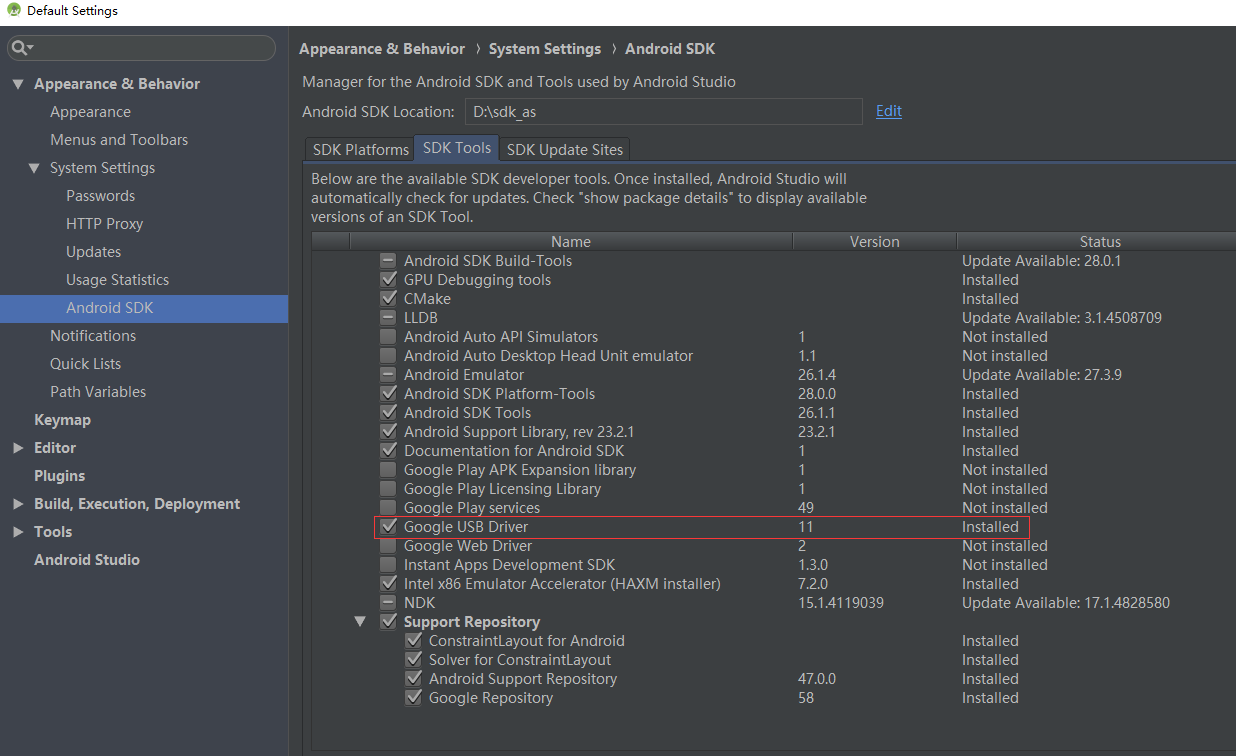

- #Setup adb in android studio how to
- #Setup adb in android studio install
- #Setup adb in android studio for android
- #Setup adb in android studio mac
* daemon not running starting now at tcp:5037ħa5ac41d unauthorized……. ? android-platform-tools was successfully installed! => Linking Binary ‘mke2fs’ to ‘/usr/local/bin/mke2fs’.
#Setup adb in android studio install
In this example below, we are creating a Nexus 5x AVD. Manually installing Android ADB USB Driver If yon dont have Android SDK installed, please install it first. => Linking Binary ‘hprof-conv’ to ‘/usr/local/bin/hprof-conv’. Create new Android Virtual Device (AVD) To take advantage of the new Android Emulator and adb speeds, you need to create new AVDs. => Linking Binary ‘fastboot’ to ‘/usr/local/bin/fastboot’. => Linking Binary ‘etc1tool’ to ‘/usr/local/bin/etc1tool’. => Linking Binary ‘dmtracedump’ to ‘/usr/local/bin/dmtracedump’. => Linking Binary ‘adb’ to ‘/usr/local/bin/adb’.

=> Installing Cask android-platform-tools First open up Android Studio and navigate to Tools > SDK Manager from the menu. => Verifying SHA-256 checksum for Cask ‘android-platform-tools’. Remote: Total 3571 (delta 25), reused 456 (delta 7), pack-reused 0
#Setup adb in android studio for android
Remote: Counting objects: 100% (3571/3571), done. Abbreviation for Android Debug Bridge, ADB for the uninitiated, provides a terminal/command-line-based interface for interaction between your computer and Linux-based Android device. MacBook-Air:~ paul$ brew cask install android-platform-toolsĬloning into ‘/usr/local/Homebrew/Library/Taps/homebrew/homebrew-cask’… Homebrew is run entirely by unpaid volunteers.
#Setup adb in android studio mac
So I had to install Homebrew ( ) It “did” a lot of work in terminal on my mac (sic?) not shure if its safe(lot of remote stuff) I did all exactly what you said: But than I found, that mac has not installed the stuff for adb’s…. See the section “Enable adb debugging on your device” at the following site: Please note, to use ADB with an Android device connected over USB, you will need to enable USB debugging. It should return something like this (if you have one Android device attached): List of devices attached To see if everything is working, connect an Android device and enter the following in the Terminal: adb devices To see what values are currently in your PATH variable, use the following: echo $PATH It is a list of directories, each separated by a colon, in which the shell looks for commands.

Note: The PATH variable is the search path for commands. Move the unzipped folder (i.e., “platform-tools”) to a useful location (e.g., I put it in a folder called “android-sdk-macosx” in a folder called “SDKs” in my home directory: ~/SDKs/android-sdk-macosx/platform-tools/).Īdd “platform-tools” to your PATH variable by invoking the following in the Terminal (make sure to change the file path to reflect where you placed the folder “platform-tools” on your system): echo 'export PATH=$PATH:~/SDKs/android-sdk-macosx/platform-tools/' > ~/.bash_profileĮxecute the following command to reload your bash profile (this applies the change to the PATH variable): source ~/.bash_profile Set the target device to listen for a TCP/IP connection on port 5555 adb tcpip 5555 Step 3. This gives you the list of devices currently connected. Unzip the downloaded file by double-clicking on it. Connect the device to the system via USB for initial setup To check whether it’s properly connected, open the built-in terminal and run the command adb devices. ADB is useful for accessing one or many connected devices (see the above photo).ĭownload the “SDK Platform-Tools for Mac” from:
#Setup adb in android studio how to
This tutorial explains how to obtain and install ADB on a Mac. The Android Debug Bridge is an application that runs on a computer to communicate with a USB connected Android device.


 0 kommentar(er)
0 kommentar(er)
